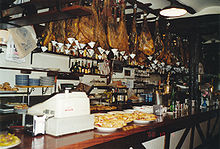Serrano ham

Serrano ham , Spanish Jamón Serrano , is an air-dried Spanish ham . Since November 1999 the traditional composition or the traditional manufacturing process of the product has been protected as a Guaranteed Traditional Specialty .
The name Serrano comes from the Spanish sierra , the Spanish word for mountains. Serrano ham originally ripened in the fresh mountain air. Known for this form of ham maturation is z. B. the place Trevélez in the province of Granada .
Characteristics
Serrano ham is characterized by its lean, hardly fat-grained meat with a mild, aromatic note. In contrast to the much more expensive Jamón Ibérico , Serrano ham usually does not come from dark-skinned Iberian pigs ( Cerdo Ibérico in Spanish ) . Rather, the meat of light-skinned domestic pigs is used for Serrano ham , which is why it is also called Spanish jamón de pata blanca (“white claw ham”) in Spain , while Iberian ham is also known as Spanish jamón de pata negra . The shoulder ham is called Paleta Serrana , while the ham is called Jamón Serrano . There are no major differences in quality, except that the ham can be cut into larger slices and only has about 30% bone, compared to 40% for the ham shoulder.
Manufacturing
The industrial manufacturing process largely reproduces the ripening process in the open mountain air, which began earlier in autumn and ended at the beginning of the following autumn with several months of storage in special storage cellars.
After the ham has been removed and cooled to around 3 ° C, the remaining blood is pressed out and the production seal with the calendar week and year is burned into the rind . The ham is then rubbed by hand with curing salt and then stored in sea salt for 0.65 to 2 days per kilogram , depending on the shape and fat content . Then the salt is brushed off. When you then hang out for the first time under strictly adhered to hygienic conditions and continued low temperatures, the penetrated salt is distributed in the ham with continued high humidity and supports the lipolysis and proteolysis processes that cause the taste. Within 30 to 60 days, the moisture content in the ham gradually decreases and the pieces develop a firmer external consistency.
During the subsequent drying phase, the temperature is slowly raised from 6 ° C to a maximum of 34 ° C and the relative humidity is reduced to a value between 60 and 80%. This promotes gradual sweating (natural fusion of a part of the fat in the tissue) and the development of flavors through protein and fat changes. The minimum duration of this phase is four months.
Only now does the actual aging take place in the bodega , a maturing cellar. The previously started biochemical processes continue to have an effect for 6 to 18 months. This is done with the help of the microflora that give the ham its aroma and taste. Each Serrano ham has matured in this way for more than six months, so a total of at least a year. When the ham leaves the bodega, it has lost at least 33% of its fresh weight ( Black Forest ham around 25%).
It can now be stored at room temperature until consumed. It is also not necessary to smoke it or treat it with paprika or other spices. Whole Serrano ham has no best before date , although it is advisable to consume it within six months of leaving the winery. The color of the ham slices goes from pink to purple in the lean part of the ham. The meat has a low fat grain and a delicate and only slightly salty taste. The maximum moisture content is 60% (in Iberian ham it is 50 to 55%) and the sodium chloride content is 15% (in Iberian ham 5%). This means that Serrano ham is less dry and salty than Ibérico ham. The shiny fat, white or yellowish in color, is aromatic and has a pleasant taste. It is found on the outside of the slice, with the exception of Duroc hams , where fine fat grains also permeate the lean meat.
See also
Web links
- Consorcio Serrano, information about Serrano ham (Spanish, English, French)
- Fundación Serrano, information about Serrano ham (Spanish, English, French)

